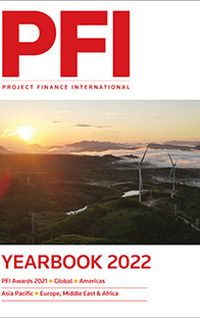An innovative flood diversion P3 brought together key features of infrastructure and environmental finance. By Alison Healey.
The Fargo-Moorhead (FM) Area diversion public-private partnership is a multi-state flood control project on the Red River of the North that borders North Dakota to the west and Minnesota to the east, flowing north to Lake Winnipeg in Manitoba, Canada. The project was developed by the US Army Corps of Engineers (USACE) and the Metro Flood Diversion Authority (MFDA) to protect the Fargo-Moorhead metropolitan area from catastrophic flooding. The MFDA is led by 13 board members from stakeholder entities including representatives from Fargo and Cass County, North Dakota, Moorhead and Clay County, Minnesota and the Cass County Joint Water Resource District.
The region has been challenged by river flooding since Fargo was founded in the 1800s. The Red River has flooded the region several times, including in 1997, 2009 and 2011, with the 1997 floods causing more than US$3.5bn in damage. The river hit flood stage in 52 of the past 114 years and in more recent history, every year except 2012 from 1993 through to 2013. Several of the river’s tributaries have also flooded and caused damage over the years.
USACE undertook the Fargo-Moorhead Metro feasibility study in September 2008 and based on its findings the federal government agreed to share the cost for a US$22m subsequent study. The goals of the study were to find a plan that reduced flood risk and damage to the Fargo-Moorhead area, restored or improved habitat along the rivers in the area, and provided additional wetland habitat and recreational opportunities with flood risk management features.
The study looked at multiple alternatives that could reduce flooding, including no action and non-structural measures, which are methods that encourage shore protection by changing the way the shoreline is used. Additional options included flood barriers and levees, and flood storage, as well as the diversion channel option. A draft feasibility report and environmental impact statement were published in 2010.
Two diversion concepts made the cut for further exploration at the end of the study, including a diversion channel in Minnesota and a diversion channel in North Dakota. The cost of the projects was estimated to range from US$1.03bn to US$1.46bn, according to early estimates.
After analysing the study and conclusions, the local sponsors including the cities of Fargo and Moorhead, Cass County and Clay County requested the North Dakota diversion plan be pursued. After further study, it was found the project would impact structures downstream all the way to Canada, so that plan was revised and a storage area upstream and levees were added to the plan.
The resulting project would work by diverting storm water from the Red River away from population centres historically affected by flooding. The channel around the western side of the city would divert excess water from the river through a diversion inlet structure south of the metropolitan area and discharge excess water to the north. The other portion of the project involves a southern embankment with upstream water staging and is being procured by USACE.
The plan was recommended to the Corps and was federally authorised through the Water Resources Reform & Development Act in 2016. The selected project includes a 30-mile diversion channel that starts just south of Horace, North Dakota along with 19 new bridges, and a 20-mile southern embankment. It is designed to provide permanent and reliable flood protection to 235,000 residents of the Fargo-Moorhead-West Fargo Metro Area and surrounding rural communities and is expected to protect over US$12bn of property value and remove flood insurance requirements for residents. It is designed to withstand a 100-year flood and to provide resiliency in the event of a 500-year flood.
As the years passed and the project evolved from when the project was initially tabled, its cost estimate increased to US$2.75bn.
The P3 portion of the US$2.1bn project is roughly US$763m. Through a partnership agreement with the USACE the project was procured utilising a split delivery approach. The MFDA partnered for the delivery of the diversion channel and associated infrastructure work package components through a P3 with RRVA, and partnered with the USACE for the southern embankment and associated infrastructure and mitigation.
The procurement process saw many stops and starts, with years between launch and selection of a winning bidder. A request for qualifications was issued in August 2016 and in October of that year the Metro Flood Diversion Authority shortlisted four teams. Lake Agassiz Partners, comprising Meridiam, Walsh, and AECOM; Red River Valley Partners, comprising Fluor, Plenary, Ames, and Barnard; Red River Valley Alliance (RRVA), comprising Acciona, InfraRed, North American Enterprises, and Shikun & Binui; and Red River Partners, comprising Graham, Parsons, Alberici, and BBGI, competed for the deal.
In June 2021 the Authority selected RRVA, led by Acciona with a 42.5% equity share, for the 34-year contract to design, build, finance, and operate the project.
The overall funding plan combines revenues from voter-approved sales taxes in the city of Fargo and Cass County, as well as funding and financing support from the states of North Dakota and Minnesota and the federal government. The MFDA was also granted US$569m from the Environmental Protection Agency (EPA)’s WIFIA programme, which was designed to accelerate investment in the nation’s water infrastructure by providing long-term, low-cost supplemental loans for projects that are deemed to be regionally or nationally significant. To-date the programme has provided US$12.1bn in financing.
RRVA achieved financial close on the Fargo Moorhead Metropolitan Area flood risk management project on October 13. A multifaceted financing backed the US$2.75bn project, starting with US$296m of senior revenue green bonds. A tranche maturing in 2051 was priced to yield 2.98% and a tranche maturing in 2056 was priced at 3.08%. The tax-exempt bonds were issued by the Public Finance Authority of Wisconsin, a conduit that lends the proceeds to RRVA. Underwriters included Citigroup, Morgan Stanley and SMBC. The consortium established a green financing framework, so all financial components of the deal were designated as green. MetLife Investment Management served as sole lender on a US$198 private placement.
A roughly US$643m revolving credit led by SMBC, CaixaBank and Korea Development Bank (KDB) and US$51m of equity rounded out the private finance contribution. The RCF is to be used for capital and then repaid through milestone and substantial completion payments. The bank loan must be repaid five days after the substantial completion payment is received and will have a final maturity that is 15 months after the originally scheduled substantial completion date at financial close. Agentis Capital was financial adviser to RRVA and EY advised the Metro Flood Diversion Authority.
Moody’s assigned an initial Baa3 rating to the bonds. The minimum and average debt service coverage ratio (DSCR) on the bonds is 1.15x. Moody’s points out that the DSCR is “relatively low” but the average cash breakeven of 50% and minimum breakeven of 35% at handback provide a cushion to accommodate cost increases.
“A true-up mechanism that requires the credit facility and privately placed notes to contribute any undrawn amounts during an enforcement event mitigates the risk of differential recovery in the event of a bankruptcy during construction,” Moody’s said.
RRVA will receive payments including US$25,000 for the first declaration of probable flood and other compensation based on subsequent events and the amount of water measured in each flood. The payments provide a hedge for increased operating or repair costs following a water diversion event, Moody’s said, but risks remain that “maintenance required after an event could exceed the revenue received".
Perhaps the most significant risk is that which the project is designed to alleviate. Moody’s notes that because the area is exposed to severe flooding risk, the risk of a flood during construction is addressed in the project agreement.
“However, despite the relief and compensation regime mitigates the risk of incremental damage costs, potential for greater costs to rectify damage remains,” Moody’s concluded. Unique to the project is a payment for the activation of the channel for a water diversion event, Moody's said.
Moody’s highlighted a number of additional risks, including the fact that the Authority has the sole discretion to declare substantial completion, so this presents higher risk of timely completion than other US P3 projects. In addition, the presence of three classes of pari passu debt instruments during the construction phase presents intercreditor risks, but structural features mitigate most of them.
The project was unique as the first climate resiliency US public private partnership, as well as the first US green finance initiative designed for climate change adaptation. It was also the first project under the United States Army Corps of Engineers P3 Pilot Program to reach financial close, the first P3 project procured by the MFDA and the first transaction in the US to combine tax-exempt private activity bonds and a private placement for long-term debt financing.
This project required true partnership between and among the MFDA, local government stakeholders, the states of North Dakota and Minnesota, two federal government agencies (USACE and EPA), and RRVA as the private sector partner.
The project faced many obstacles and formidable opponents over the past several years. The Minnesota Department of Natural Resources (DNR) asked a federal judge to delay action on the project based on concerns that it will damage farmland upstream and also alleged alternative plans to protect the region from flooding had not been sufficiently considered. A group of North Dakota and Minnesota residents upstream from the channel filed a federal lawsuit in 2013 that extended and was ultimately settled earlier this year, enabling construction to start. The agreement requires the diversion authority to provide compensation and flood prevention to areas at risk of negative impact from the project, including flooding.
The ability of the project to reach financial close may raise the possibility of other bespoke P3 transactions that solve specific problems. Certain aspects of the transaction were specifically tailored to the distinct pattern of flooding and community needs, and portions could potentially be applied to other P3s, according to Ashurst, which advised the public sector authority on the scheme.
The US Army Corps of Engineers (USACE) viewed it as a “pathfinder” project and is looking at two other environmental projects as part of its P3 pilot programme; the Brazos Island Harbor channel improvement project in Texas and the Los Angeles River ecosystem restoration project.
The project set a new standard for project development and financing in terms of the use of P3 for infrastructure projects with an environmental component as well as its use of the split delivery model.
To see the digital version of this report, please click here
To purchase printed copies or a PDF of this report, please email gloria.balbastro@lseg.com

















